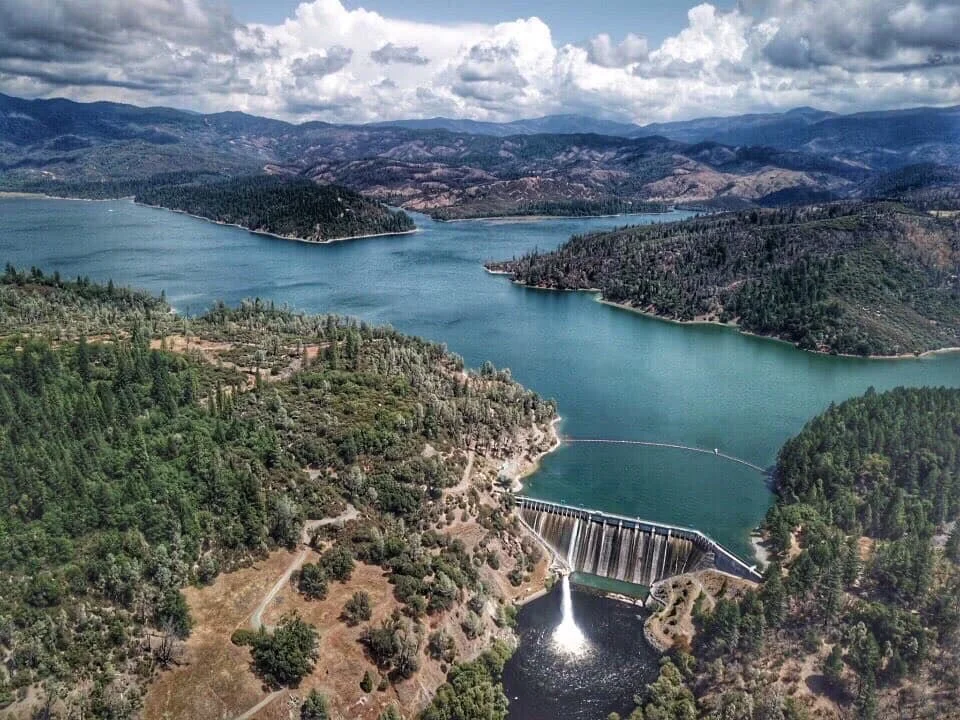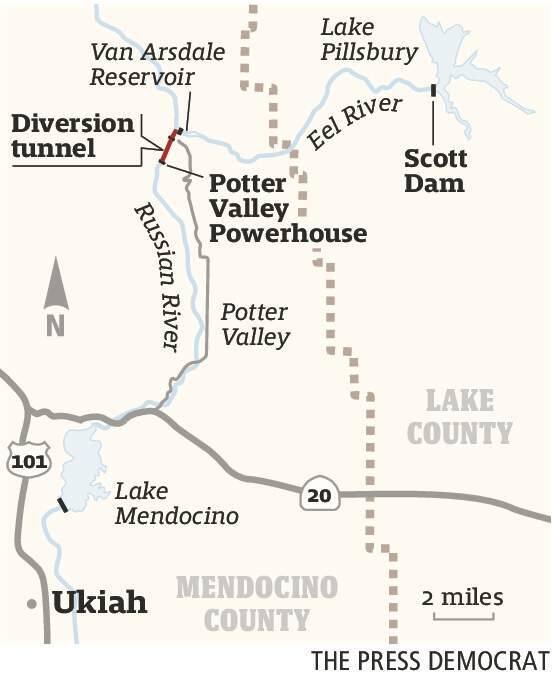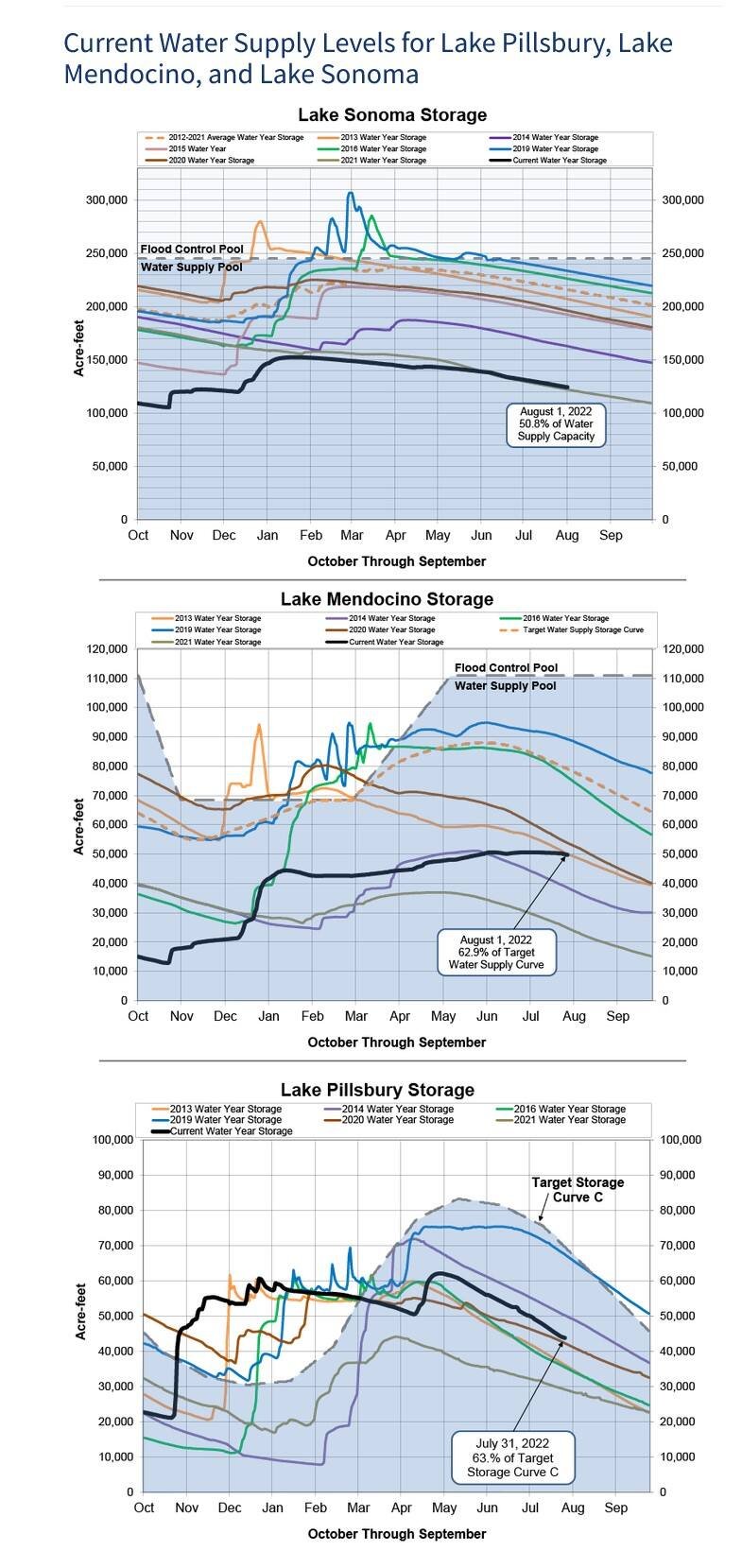MENDOCINO Co, CA, 3/26/23 — Pacific Gas and Electric (PG&E) is about eight months into a 30-month planning timeline for the license surrender of the Potter Valley Project, a system of dams and hydroelectric power that has diverted water from the Eel River to the Russian River since 1908 and made a lasting mark on the region’s productivity, environment, and lifeways. But the way forward is uncertain. In 2025, PG&E could decide that one or both of the project’s dams will be removed, the project could continue to run under a new license operator, or one of myriad options in between.
Further, a variety of factors complicating the already controversial project have emerged — and last week, PG&E announced that the spillway gates at Scott Dam will remain open this spring and in future years due to the potential for seismic activity in the area. This will mean less water storage in Lake Pillsbury, complicating the usual systems of water flow ahead of any infrastructure changes at the dams.
Also last week, a new working group under the name of the Russian River Water Forum has been formed by local water leaders to explore ways forward for the project and to negotiate with PG&E. This new group could be viewed as a second coming of the Two-Basin Partnership, a now-dissolved initiative to form a regional entity to take over the license from PG&E that was led by Representative Jared Huffman.
The summer’s news also remains a factor in the project’s future. After PG&E announced its decision not to renew its 50-year license from the Federal Energy Regulatory Commission (FERC), taking up an interim annual license for the duration of the project decommissioning, the National Marine Fisheries Service (NMFS) wrote to FERC saying that project operations were negatively impacting salmon and steelhead survival to an extent not permitted under the Endangered Species Act (ESA). In response, multiple local fish and fisheries advocacy groups sued FERC over unauthorized “take” of (or harm to) endangered fish.
Whole landscapes and communities of Northern California have been defined and changed by the Potter Valley Project. As rancher Frost Pauli told The Mendocino Voice, his family moved to Potter Valley in the 1920s “as a direct result of water being available there for agriculture — and we’ve been farming there ever since.”
“It’s much bigger than a single project or a single piece of infrastructure,” Frost Pauli reflected. “It’s a regional issue that affects six different counties, hundreds of thousands of people, thousands of acres of land, and of course, two huge river systems and the environment in those river systems. … [Resolution] is going to be a marathon, not a sprint.”
Scott Dam news: the tension between infrastructure and water supply
New analyses have forecast that Scott Dam, the project’s diversion mechanism at Lake Pillsbury, is threatened by possible seismic activity, the impacts of which could be exacerbated by greater water storage. Keeping the spillway gates open is a decision made “in the interest of community safety,” due to new information as the capacity to study earthquake potential continues to advance.
“While risks to the dam remain very low, by reducing water levels in the reservoir we can mitigate against risk,” said Jan Nimick, vice president of Power Generation at PG&E. “Storing less water in the reservoir (a 26% reduction compared to a full reservoir) lowers the water load on the dam, thereby significantly reducing the risk during or after a seismic event.”
More water will likely flow in the Eel River this spring, but less water will be stored in Lake Pillsbury for summer and fall water releases that support cold water fisheries below Scott Dam, Russian River agricultural interests, and recreation on the lake. According to PG&E’s release, the flow to the Russian River — which the utility plans to apply for a variance from FERC to decrease — will probably mimic drought-stricken summers such as 2020 and 2021, despite our dramatic rain and snowfall this year.
“Today’s announcement from PG&E makes it clear that maintaining the status quo for the Potter Valley Project is no longer an option,” fisheries advocacy nonprofit California Trout said in a statement. “We continue to encourage Russian River water users that have benefited from Eel River water diversions for the past century to plan for a future without those diversions, or to explore options for an ecologically sound, dam-free diversion facility.”
Janet Pauli, who has served on the Potter Valley Irrigation District Board of Directors since 1988 and represented the district at the Mendocino County Inland Water and Power Commission (IWPC) since 1996, said the IWPC will likely be involved in the variance request proceedings as well as looking to longer-term solutions to compensate for water storage at Lake Pillsbury.
“It’s a very serious concern, and something that we actually hadn’t anticipated at this point in time,” she said.
Elizabeth Salomone, general manager of the Russian River Flood Control & Water Conservation District (RRFC) is charged with maintenance of 86 diversions along the Russian River (primarily for agriculture customers). Because this water is not necessarily the only supply for many of those customers, she feels that this year could go okay; they have greater reserves to draw from than after recent dry seasons. But that’s not a long-term solution.
“If we don’t get significant rainfall in this next winter, we could be looking at some very dire circumstances,” she said. “We really can’t afford to miss another wet winter. We’re going to need above-average rainfall pretty much every winter to keep us afloat.”
Further, Salomone says that our drier, hotter summers increase the need for irrigation and further burden the water supply. This pendulum of extremes — with a torrent of atmospheric rivers moving through California this winter — is not very conducive to stable water supply.
“We don’t have the capacity to benefit from that as far as storage,” she said. “Our reservoirs fill up, the ground fills up, the natural waterways fill up. There’s only so many buckets and barrels you can put out. We just don’t have any more room.”
How does the Russian River Water Forum factor in?
Between months three and eight of its schedule for establishing a decommissioning plan, PG&E had planned to “conduct initial outreach to agencies and other stakeholders to solicit relevant information for the preparation of the surrender application and decommissioning plan.” Multiple sources interviewed for this article told The Voice that PG&E had not formally engaged their organizations in discussion around the project during recent months.
“PG&E is probably not interested in dealing with a lot of different individual entities,” Janet Pauli explained. “They want a formed, functioning regional group that represents everyone but can speak almost independently, and is capable of taking on a project that won’t be cheap to operate.”
After PG&E announced plans not to renew its 50-year license expiration, Huffman tried to answer this call with the Two-Basin Partnership. The partnership brought together California Trout, Humboldt County, IWPC, the Round Valley Indian Tribes, and Sonoma County Water Agency. It initiated discussions across a variety of different interests, and commissioned studies on solutions that would balance water supply needs; thriving ecosystems; and public health.
But the partnership failed to meet FERC’s Apr. 14, 2022 license application deadline.
“We prepared quite a lot of information,” Janet Pauli said. “It wasn’t as if we didn’t have anything done, but we didn’t get enough done by the end to be able to prepare a license application by the date it was required by FERC. We ran out of time and money.”
Almost a year later, enter the Russian River Water Forum. The project’s website launched last week, created by Sonoma County Water Agency and other regional partners, with funding from the California Department of Water Resources.
“The Water Forum will seek to identify water-supply resiliency solutions that respond to PG&E’s planned decommissioning of the Potter Valley Project while protecting Tribal interests and supporting the stewardship of fisheries, water quality, and recreation in the Russian River and Eel River basins,” the website details. “More broadly, the Water Forum will support ongoing regional collaboration on water supply and watershed restoration issues in the Russian River and Eel River basins.”
Once its charter is finalized, the forum’s Planning Group will include 30 members from Lake, Sonoma, Mendocino, and Humboldt counties, and will hold public meetings and workshops throughout 2023.
“How do we maintain some amount of diversion from the Eel to the Russian that is fair and equitable?” Salomone said, outlining the Forum’s guiding questions. “All the stakeholders can have a voice in that and raise concerns, and develop a local solution to that continued diversion, however it may look. Another focus will be general water resiliency in the watershed, [in addition to] water reliability and availability. When we do have these really difficult times, how do we sustain ourselves through them?”
An eventual goal would be for the Forum to build capacity to carry the project forward into the next stage of its life — and as Janet Pauli points out, “speed is of the essence.”
“We hope that a regional entity will form from the feedback and advice of this group, and then that entity will become a legal one that can begin those formal discussions with PG&E and FERC,” Salomone confirmed. “Because someone’s going to have to take over the project, the diversion in the water, and then deliver that water to the Russian River.”
What’s the best way forward?
In the midst of these significant new developments around the Potter Valley Project’s uncertain future, a new study was published by the Bay Area Council Economic Institute forecasting the economic impact that removal of both Scott and Cape Horn dams could have on the project’s five immediate surrounding counties.
The study’s introduction argues that removal of both dams is a likely outcome because of the “reasonable initial capital outlay for PG&E and the minimal long-term operation and maintenance costs associated with dam removal relative to long-term operations and maintenance costs coupled with ongoing state and federal liabilities surrounding fish passage, environmental compliance, and dam safety without a continued revenue source.”
According to its look at the immediate impacts of removal, the projects would support 1,037 to 1,332 full-time equivalent job years in the five-county region, and around $203 million to $278 million of economic output for that region alone.
“There’s this paradigm of fish versus people or nature versus people that’s something that we always battle in the environmental space, because it’s just not true,” Charlie Schneider of California Trout told The Voice. “Studies like this are really helpful in showing that the removal is essentially a big construction and restoration project, and there are economic benefits to the community that come from doing that kind of work.”
Schneider said that promoting fisheries interests can feel like an uphill battle, especially when protected fish in the Eel River system have been depleted to the tune of less than 10% of their historic populations.
“Are we going to right this?” he asked. “Salmon populations are in dire shape up and down the state as evidenced by the closure of this year’s salmon season. Its important to realize the impact of that is lost jobs, lost livelihoods on the coast and a loss of part of their culture for Eel River and other tribes. There are solutions that can benefit fish and people. I think decision makers are starting to lose sight of that because that story isn’t being told anymore, because there are so few salmon fishermen. … It’s been so many bad years in a row, in part because of decisions around how we steward our rivers and whose interests get prioritized.”
For farmers in the Russian River watershed, water from the diversions is essential for agricultural supply, meaning that removal is not necessarily the obvious solution. Frost Pauli, of Pauli Ranch and the Mendocino County Farm Bureau, explained that from the bureau perspective, the status quo has been working well. But in advocating for these solutions, the volunteer-governed farm bureau favors outcomes that make sense across a variety of different interests in the century-old project.
“We are not opposed to dam removal,” Frost Pauli said. “If it makes sense for the environment, and if it makes sense for the economy, and if it makes sense for the safe operation of this infrastructure to the benefit of both basins. … If all of those concerns can be met, then dam removal makes sense.”
Janet Pauli has been involved in feasibility studies for different solutions projects, including raising Coyote Valley Dam by 30 feet, or engineering a dam at the north end of Potter Valley to augment existing storage at Lake Mendocino.
“There’s a lot of work that still has to be done to ensure that is possible,” she explained. “And that’s what we’ve been working on.”
“When people don’t get involved, they’re just abdicating their power”
Salomone believes that the formation of the Russian River Water Forum is an “important and significant step,” but also notes that these opportunities for engagement in the future of both basins are only as good as who shows up.
“I attend a lot of public meetings of those who are managing water, and I rarely see the public there,” she said. “And I get it … but it’s time for folks to figure out where they’re getting their water [and] what condition their water supplier is in. Is it really stable — they have a lot of revenue and a lot of reserve, they have resiliency projects, and they have a diverse portfolio of the water sources — or are they a sole-source water supplier, and that source is threatened? I’ll tell you, in the greater Ukiah area, we have both extremes. … It’s really important for people to understand where they are on the spectrum of water reliability.”
Janet Pauli agrees, saying “our project has never been easy in terms of discussions, because this has always been controversial.” But from her perspective, representing a diversity of interests is critical to find a viable solution.
“It requires our diligence in moving forward,” she said. “The more voices we have at the table [the better], so we can understand the concerns of all groups, including folks on the Eel River side, Lake County, tribal members on both watersheds, environmentalists, agencies who are charged with protecting the fishery in both watersheds, water suppliers, or local government. … I’m hopeful that we will get to a place where we can continue the diversion, which is what we agreed upon in the [Two-Basin Partnership], and at the same time, be more protective of rivering conditions on the Eel, and not forget the conditions on the Russian River that are important for listed fish here as well.”
As Salomone put it: “When people don’t get involved, they’re just abdicating their power.”
Note: Kate Fishman covers the environment & natural resources for The Mendocino Voice in partnership with a Report For America. Her position is funded by the Community Foundation of Mendocino, Report for America, & our readers. You can support Fishman’s work with a tax-deductible donation here or by emailing publisher@mendovoice.com. Contact her at KFishman@mendovoice.com or at (707) 234-7735. The Voice maintains editorial control and independence.






